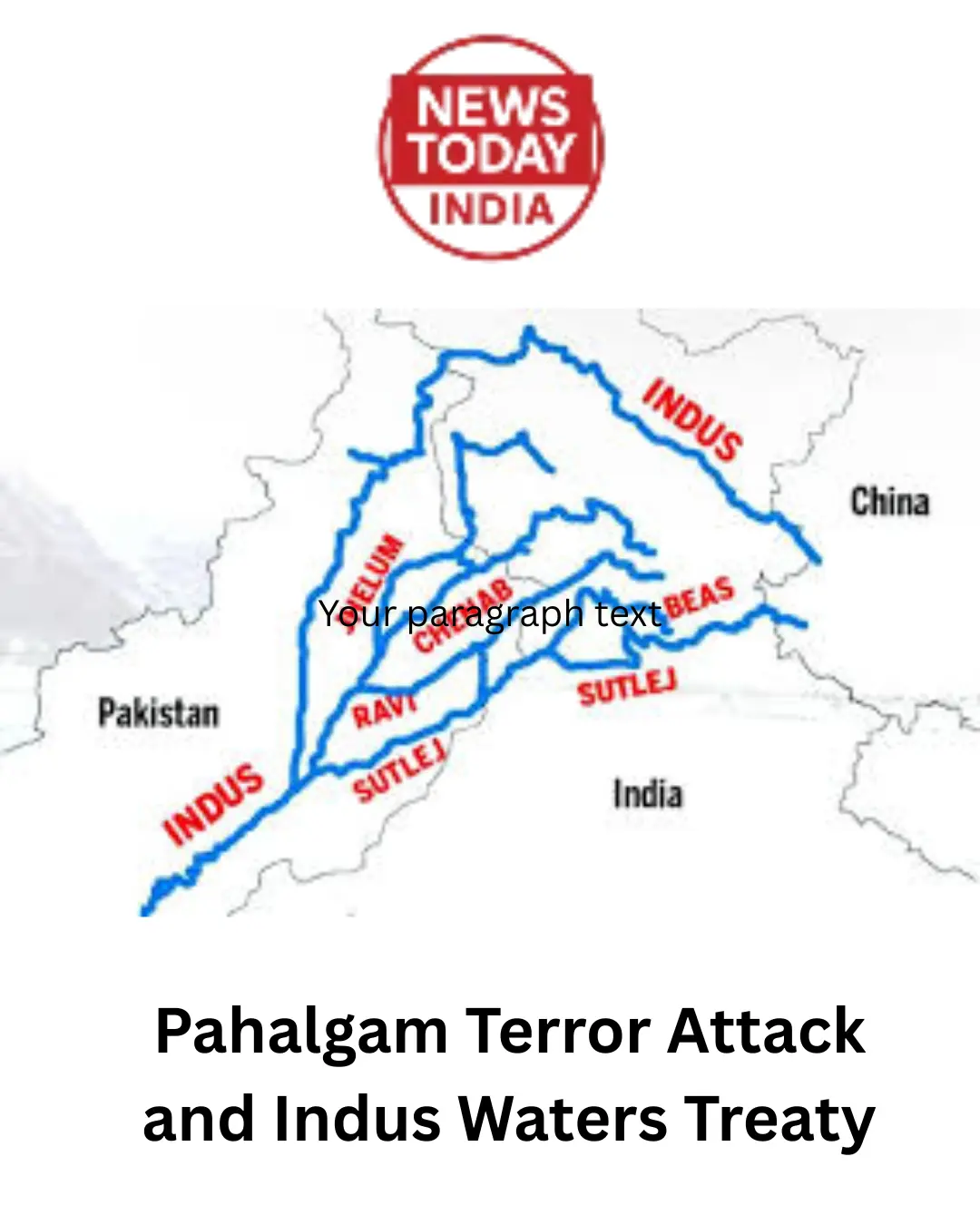Subtotal $0.00
News Today India | April 24, 2025
India has taken a bold step by stopping the Indus Waters Treaty (1960), raising concerns about Pakistan’s water supply. This decision comes as a response to the Pahalgam terror attack on April 22, 2025, which killed 26 people. India says the treaty will remain on hold until Pakistan stops supporting cross-border terrorism. Pakistan has only 4.7% of its land covered by forests, which is not enough to attract rain clouds. If India cuts off water, what will happen to Pakistan’s forests and rainfall?
What is the Indus Waters Treaty?
The Indus Waters Treaty was signed in 1960 between India and Pakistan. It divides the water of six rivers—Indus, Jhelum, Chenab, Ravi, Beas, and Sutlej. India controls the Ravi, Beas, and Sutlej (Eastern Rivers), while Pakistan controls the Indus, Jhelum, and Chenab (Western Rivers). These Western Rivers provide 80% of Pakistan’s water for farming and daily use. India’s decision to stop the treaty means Pakistan may lose access to this water, which could harm its economy and environment.
The Pahalgam Attack and India’s Response
On April 22, 2025, a terror attack in Pahalgam, Jammu and Kashmir, killed 26 people, mostly tourists, in Baisaran Valley, known as “Mini Switzerland.” The attack was carried out by Lashkar-e-Taiba and The Resistance Front, groups supported by Pakistan. In response, Prime Minister Narendra Modi cut short his Saudi Arabia visit and returned to Delhi. On April 23, India announced five strong decisions, including stopping the Indus Waters Treaty, to pressure Pakistan to end terrorism. This move has sparked debates about its impact on Pakistan’s water, forests, and rainfall.
Pakistan’s Forests: Only 4.7%
Pakistan has forests on just 4.7% of its land, about 3.73 million hectares, according to World Bank (2022) data. This is much lower than the global average of 31.2% and South Asia’s 18.9%. Forests are mainly in these areas:
- Khyber Pakhtunkhwa: 20.3% forest cover, 32.7% of Pakistan’s total forests.
- Azad Jammu and Kashmir: 36.9%, the highest.
- Sindh: 14.8%.
- Punjab: 12.4%.
- Balochistan: 11.1%.
- Gilgit-Baltistan: 7%.
Pakistan’s forests do little to attract rain clouds. Trees release water vapor, which can increase local humidity, but this works only on a small scale. Pakistan’s rainfall depends mainly on ocean winds (Arabian Sea, Indian Ocean), monsoons, and Himalayan geography. With only 4.7% forests, they cannot significantly influence rainfall.
What Happens if India Stops Water?
If India stops water from the Indus, Jhelum, and Chenab rivers, Pakistan will face serious challenges. These rivers are vital for farming, water supply, and the economy. Here’s how it could affect Pakistan:
1. Impact on Farming
Pakistan’s 62% farmland depends on these Western Rivers. They provide 70 billion gallons of water for crops like cotton, wheat, rice, and sugarcane. If water stops:
- Crop production could fall, leading to food shortages.
- Cotton, which makes up a third of global supply, will be hit hard.
- The economy will suffer, as farming accounts for 24% of Pakistan’s GDP.
2. Impact on Forests
Most of Pakistan’s forests (like in Khyber Pakhtunkhwa and Azad Jammu and Kashmir) rely on rainfall and groundwater, not river water. But:
- Mangrove forests in Sindh’s Indus Delta need freshwater. No water could destroy them, causing coastal erosion and loss of wildlife.
- Irrigated forests (3-4% of total forests) will also suffer without river water.
- Less water could increase soil erosion and desert spread, harming forests further.
3. Impact on Rainfall
Stopping water won’t directly affect rainfall, as Pakistan’s rain comes from ocean winds, monsoons, and Himalayan glaciers. But:
- Over time, less water could dry out soil and plants, reducing local humidity and small-scale rain.
- Climate change is already making rainfall unpredictable. From 2017-2020, droughts in southern Pakistan cut rainfall sharply. Low forests make this worse, but the main causes are ocean and Himalayan patterns.
4. Water Shortage
Pakistan is already water-stressed, with only 1017 cubic meters of water per person in 2021. By 2025, this could drop below 500 cubic meters, a severe shortage. If water stops:
- People will rely more on groundwater, overusing wells. The Indus Basin is already the world’s second most stressed aquifer.
- Cities like Karachi and Lahore may face drinking water shortages.
- Water scarcity could force people to move from cities to villages, causing social tensions.
5. Economy and Society
Water shortages will hurt Pakistan’s economy. Farming and hydropower (electricity from water) will suffer. Food insecurity, job losses, and social unrest could rise. The 2022 floods displaced 33 million people, and water scarcity could trigger similar crises.
Can Forests Bring Rain?
Pakistan’s 4.7% forest cover is too small to attract rain clouds. Large forests like the Amazon can influence weather, but Pakistan’s dry and sub-tropical forests cannot. Still, forests help keep soil moist and prevent erosion. However:
- Himalayan Role: 80% of Pakistan’s water comes from Himalayan glaciers and rainfall. Forests help store this water but don’t create rain.
- Climate Change: Unpredictable rainfall is already a problem due to global warming. Low forests make it slightly worse, but ocean winds and monsoons are the main drivers.
Pakistan’s Efforts to Grow Forests
Pakistan is trying to increase its forests:
- Ten Billion Tree Tsunami Program: From 2018-2021, 859 million plants were planted, with a goal of 3.2 billion trees by 2023. In Khyber Pakhtunkhwa, forest cover grew from 20% to 27% (2014-2019).
- Mangrove Restoration: Sindh’s Indus Delta is seeing efforts to grow mangroves, which protect coasts and boost local humidity.
- Challenges: Illegal cutting, city growth, and demand for firewood are destroying forests. Growing forests needs long-term plans and funding.
Will India Really Stop Water?
Stopping the Indus Waters Treaty is a major move, but fully cutting off water is not easy:
- Legal Issues: Breaking the treaty violates international law. India threatened to do this after the 2016 Uri and 2019 Pulwama attacks but didn’t act.
- Past Actions: The Shahpur Kandi Barrage (2024) stopped Ravi River water, which was India’s right. But stopping Western Rivers is harder, as they are critical for Pakistan’s survival.
- Political Pressure: Anger over terrorism in India is pushing for tough actions, but experts say completely stopping water could harm India’s global image.
What’s Next?
If India stops water, Pakistan will face tough times:
- Farming and Economy: Crop failures and power shortages will hurt jobs and food supply.
- Forests and Environment: Mangroves and irrigated forests could die, leading to more desert and erosion.
- Rainfall: Rain won’t stop immediately, but long-term environmental damage could reduce local rain.
- Water Crisis: Pakistan’s water shortage will worsen, affecting millions.
To tackle this, Pakistan needs:
- Better Water Management: Build dams, recycle water, and improve irrigation.
- More Forests: Strengthen the Ten Billion Tree Program.
- Climate-Smart Farming: Grow crops that need less water.
- Global Help: Work with other countries on climate and water solutions.
Stay Updated with News Today India
News Today India brings you the latest on the Pahalgam terror attack, Indus Waters Treaty, and Pakistan’s forests and water crisis. Visit our website for updates on Pakistan environment, India-Pakistan relations, and climate change. Share this story to spread awareness about this critical issue.








